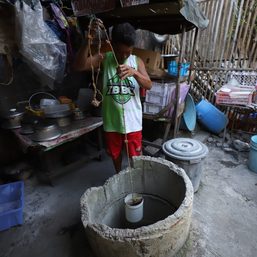SUMMARY
This is AI generated summarization, which may have errors. For context, always refer to the full article.

READ: Part 1 | Flood-prone lifelines: Critical facilities at risk of flooding in Negros Occidental town
NEGROS OCCIDENTAL, Philippines – In Sipalay, critical facilities such as health facilities and schools were built in flood-prone areas. The local government is aware of this, yet these facilities have not been relocated even after being devastated during past disasters.
In the first part of this investigation, Rappler found that over half of Negros Occidental residents are at high risk of danger due to floods. Across the province, Sipalay ranked high among towns, with the most critical facilities constructed in flood-prone areas. At least three in 10 of these are located in vulnerable areas.
Negros Occidental also ranked 11th out of 84 provinces in terms of exposure to multiple hazard risks, the 2021 Philippine Province Risk Profiles of Pacific Disaster Center (PDC) said.
During Typhoon Odette (Rai), Sipalaynons experienced firsthand how taking refuge in schools that double as evacuation centers can still expose them to flood risks. For them, it was a wake-up call. But for the local government, it didn’t appear to be enough.
Sipalay officials plan to construct two evacuation centers and relocate a few schools, but the relocation of all critical facilities away from flood-prone areas remains a challenge. Experts said that moving them out of flood zones is a complex process, and finding a solution that checks all the boxes takes time.
Officials aware of flood risks
Months of analysis by the state hazard assessment portal HazardHunterPH data showed that Sipalay has the most number of schools among Negros Occidental towns with a very high risk of flooding. In the Philippines, schools serve as evacuation centers during disasters.
The Sipalay City government said it is aware of the flood risks.
As part of pre-disaster meetings, the local government unit (LGU) uses government hazard maps from the environment department’s Mines and Geosciences Bureau (MGB) and follows warnings from state weather bureau Philippine Atmospheric, Geophysical, and Astronomical Administration (PAGASA). They identify areas that might be affected and stock food and other necessities in those barangays.
Days before Odette hit, city officials said all the necessary preparations were made, save for mandatory evacuation. For them, it was the “lack” of information dissemination on the part of village officials and the reluctance of the residents to evacuate and listen to warnings that cost lives.
“The barangay was nowhere to be found, to be honest. They are part of the warning system but they are too lazy, probably,” Sipalay City Mayor Gina Lizares said.
Locals interviewed by Rappler confirmed that some of them knew about Odette’s strength due to the announcements made by the city government and the village officials, while others said they were not informed by the barangay beforehand.

At Sipalay City National High School (SCNHS), the designated evacuation center in Barangay V in the city proper, floodwaters reached the ground floor of the school, prompting evacuees to seek refuge on the second floor of the building.
Sipalay officials said that the Sipalay City gymnasium, a larger facility located in the center of the city proper, was also used as an evacuation center. Both the city gym and SCNHS are located in a very high-risk flood zone.
Towns with a high risk of floods may be submerged in one to two meters of water for over three days, according to the MGB. For most Filipinos, this is already waist- to chest-deep. Those with a very high susceptibility to floods may see more than two meters.
“As far as I know, flood-prone schools are not used as evacuation centers. They are usually brought to our covered courts and gymnasiums. Even if there’s flooding in that area, the gym is more protected,” Lizares said. Her staff confirmed the flood did not reach the city gym.
Since Odette, village officials have been advised to not use the evacuation centers located within their barangays, especially for expected major disasters. Instead, they were told to evacuate to the facility in Gil Montilla in central Sipalay which would be safer, according to disaster officials. Gil Montilla is where the city’s new government center was built.
“What we wanted to instill in the barangays is no matter what the weather condition might look, if PAGASA says the typhoon will be disastrous, they shouldn’t be complacent. They must do what they need to do,” the city’s Public Safety Officer Dionilo Bogtae said.
The city government also moved to strengthen the village disaster risk reduction and management (DRRM) offices by conducting more training so that they would be able to fend for themselves if the unimaginable happens.
“We know that the [city] DRRMO can only handle a few [areas] when it comes to disaster. Remote areas should know how to handle themselves,” Sipalay City Information Officer James Lim said. “During Odette, the rescuers were here and they could not access the barangays. They could not access the roads going to remote areas because of the debris in the flood.”
Moving schools out of harm’s way
Odette hit at a time when the Philippines was still reeling from the impact of the COVID-19 pandemic.
By the end of 2022, Sipalay had already used up around three-fourths of its disaster funds. The mayor said the main expenditure that year was the response to the aftermath of Odette, on top of expenses related to the pandemic. Then, Severe Tropical Storm Paeng (Nalgae) hit the city in late 2022.
Data from the Commission on Audit showed that Sipalay spent P56.6 million out of its P72.3 million ($1.3 million)* worth of disaster funds in 2022. Of the budget, the city spent around P800 ($14) per resident. Sipalay had the highest disaster spending per resident among LGUs in Negros Occidental – almost thrice the provincial average of about P260 ($5) in 2022.
While this is considered a relatively high utilization rate, Lizares said their aim is to spend even more of their disaster funds in the coming years – at least 80% compared to the current 78% utilization rate.
“During [the COVID-19 pandemic], we were very focused. We wanted to see to it that we are proactive, not reactive. So we used the funds for the things we foresaw that we’d need in the future during that time,” Lizares said.
Sipalay officials told Rappler the city aims to relocate a few of the schools being used as evacuation centers because of the risks. But Lim said that the city is facing land ownership issues in the process.
Cabadiangan National High School is among the schools eyed for relocation to a “higher elevation.” The high school, despite being in a “safe” location, according to state hazard maps, is close to flood zones that may block residents' access to roads.
The high school is located in the barangay that saw the most deaths during Odette.

The plan to relocate the Cabadiangan public school has been ongoing, and the city has already discussed its plan with the Department of Education (DepEd).
Lim said the city has been looking for landowners who may want to sell land. Officials also explored another site, but they need approval from the Department of Environment and Natural Resources since part of the area falls within forest land.
For other flood-prone schools, the information officer said the city is still looking for new sites for their relocation.
As for SCNHS, Lizares said it would be moved to a different location not because of flood risk but because the lot it occupies belongs to Barangay V Elementary School.
“The only reason we are planning to move [SCNHS] out of there is because two schools in one area are too crowded. When it (elementary school) expands, we need the bigger area that is already occupied by the high school,” the Sipalay mayor said.
Relocation: A complex process
In the Philippines, evacuation centers, health facilities, and schools built in flood zones are more common than you think.
A 2019 peer-reviewed study found that almost half of all evacuation centers in Metro Manila are also at risk of floods. The researchers of the study recommended “reevaluating” the locations of evacuation centers to facilitate prompt disaster response.
To do exactly that, disaster risk management experts told Rappler that the government needs to face several hurdles to move critical facilities to safety.
The operations center director of the Philippine Disaster Resilience Foundation (PDRF), an organization that serves as coordinator for DRRM activities for the private sector, said there are many considerations in relocating evacuation centers – relocation costs are one thing, finding new locations is another.
“For a country that is at the top for natural hazard exposure, it may be challenging to identify a suitable location for these facilities that also meet necessary criteria such as proximity to the community, public transport accessibility, connection to basic amenities, among others,” PDRF’s Arnel Capili told Rappler.
Capili has decades of experience in disaster risk management. He used to be the regional director of the Department of National Defense’s Office of Civil Defense (OCD) in Bicol from 1997 to 2007.
According to him, relocation involves logistical challenges that, if not addressed properly, can lead to delays. And a country that is exposed to multiple hazards, including an average of 20 typhoons a year, cannot afford delays.
“Relocation is indeed a complex process, hence, moving forward, it is important for the government to get things right from the start by conducting a thorough risk assessment in selecting sites for new facilities, including working with experts to incorporate resilient design features,” Capili said.
Meanwhile, Ricardo Jalad, ex-OCD administrator and former executive director of the National Disaster Risk Reduction and Management Council, pointed out that relocation “depends on the resources available and the priorities of the office concerned.”
Under the law, LGUs must allocate at least 5% of their revenues to the local disaster fund. Ideally, the wealthier a city is, the higher its disaster funds. Jalad suggested that the national government come in because all critical facilities that it constructs are put under strict evaluation by the RDRRMC.
“Maybe [the Department of Public Works and Highways] should include in their annual budget the relocation of critical facilities like schools, evacuation centers, and health facilities from no-build areas to safe areas,” Jalad said.
The former NDRRMC chief pointed out that, ultimately, it comes down to whether local governments will take decisive action.
“I think it’s a matter of political will on the part of the LGUs on the enforcement of their comprehensive land use plans (CLUP) and related powers like issuance of building permits [when building new schools],” said Jalad.
Under Republic Act No. 7976 or the Local Government Code, LGUs are mandated to have CLUPs and keep them updated. In a guide created by the former Housing and Land Use Regulatory Board, the precursor to the housing department, LGUs are encouraged to analyze risks for areas that may be affected by hazards. Land zoning recommendations could range from implementing a no-build zone for a specific area to managing risks instead.
Building evacuation centers can be costly
If the relocation of critical facilities is too complex a problem, why not build new ones then?
According to Capili, the national government should set “broad” policies and regulations related to the identification of the sites for construction, and safety standards, among others. Local governments should localize such policies to their needs, ensure that these are followed, and make specific decisions regarding site selection, design, and construction.
In the case of Sipalay, the mayor also does not think relocating schools in the city proper would be wise. “The whole poblacion (city proper) is at high risk, so why just move the schools?”
The mayor said that the city is building two evacuation centers for Sipalaynons – one at Gil Montilla and one in the city proper. Construction of the P16.9-million ($305,000) evacuation center in Gil Montilla started in December 2020. It is still ongoing.
Capili agrees that building new evacuation centers may be better than relocation.
“It is probably more practical to construct new evacuation centers that satisfy current building codes, aligned with standards [such as] PWD (persons-with-disability) access, lactation rooms, et cetera, and more importantly, away from hazards that may potentially impact its safety.”
In March 2023, the House of Representatives approved on third and final reading House Bill No. 7354, which seeks to mandate every city and municipality to have at least one permanent evacuation center that is up to par with national government and international standards.
The counterpart measure at the Senate has passed the committee level but has yet to be taken up at the plenary.
According to the House bill, permanent evacuation centers must be designed to withstand wind speeds of at least 300 kilometers per hour (km/h) and earthquakes of at least magnitude 8. To put this requirement in context, Super Typhoon Yolanda (Haiyan) had maximum sustained winds of 315 km/h, while the strongest earthquake that hit the Philippines was the magnitude-8 Moro Gulf quake in 1976.
Aside from structural requirements, the bill also proposes that the new facilities be well-ventilated, have a large capacity, and have amenities such as sleeping quarters, one shower and one toilet per 20 persons, and food preparation areas, among others.
It comes with a hefty price tag for the national government, eyed by Congress to be the sole financier for this ambitious undertaking.
In a discussion paper, the Congressional Policy and Budget Research Department (CPBRD) in the lower chamber estimated that building a two-story evacuation center for each of the over 500 cities and municipalities in the country would require P33.4 billion ($602 million), or an average of P64.8 million ($1.17 million) per building, aside from the price of land where it would be built.
The policy research office used Department of Public Works and Highways (DPWH) costing for a 2019 evacuation center project and computed for 2022 prices.
The CPBRD noted that the total amount needed to finance the program would be a huge expenditure for the national government – plus, the DPWH has a track record of having a weak absorptive capacity, or its inability to efficiently spend money to complete projects without delay.
In CPBRD’s estimates, a new evacuation center in Western Visayas, the region where Negros Occidental is located, would cost around P62.6 million ($1.13 million), which is easily about 90% of Sipalay’s total disaster funds in 2022.
In contrast, the evacuation center at Gil Montilla being built by the Sipalay City government is around two-thirds less expensive. PDRF also told Rappler that it built multipurpose facilities that serve as evacuation centers during disasters at P25 million ($451,000) each, which is half the price of the CPBRD’s estimate.
If the bill is passed, the policy research office recommends that the government explore other financing options for this program, including climate financing or partnerships with the private sector. It also said it would slash costs if the LGU donated land for the evacuation center.
‘Demand investments in preparedness’
Experts agree that investing in preparedness goes a long way than focusing resources on response. Capili noted, however, that investments in preparedness or DRR are “not that visible” to the public.
The disaster risk expert noted that investment in preparedness comes with a good early warning system, robust emergency communication system, and evacuation centers built according to standards.
“To make matters worse, they (long-term investments) can be more costly and more time-consuming – beyond the 3-year term of locally-elected officials,” Capili said.
Take Sipalay’s evacuation center as an example. Construction in Gil Montilla started in late 2020 and has been ongoing for over three years now, outliving the pandemic and the last local election in 2022.
Capili said that residents should start demanding higher investments in disaster preparedness from their local governments.
“What is more important is to highlight the long-term benefits from investments in preparedness and DRR rather than a short-term dole-out mentality.… By doing so, governments can minimize the costs associated with recovery and rehabilitation, and more importantly, families can now shelter in place,” he said.
More than two years after Odette, Sipalaynons still have vivid memories of their harrowing experience during the typhoon.
Looking back, Felizardo dela Cruz, a Cabadiangan resident whose house was swept away by floods with him in it, said that he would have evacuated to a safer place if the Sipalay government had asked him to.
Narcisso Biasong, whose wife and grandchild died after trying to seek shelter from the raging typhoon, resented the city government. “I was sleepless after Odette.… When someone asks her (mayor) how is Sipalay, she just answers, ‘We’re okay.’ Is it really ‘okay’ if many people died?”
While the issues with evacuation centers are being discussed by the government, many Filipinos – not just in Sipalay – will have no choice but to continue putting their lives at stake by depending on these high-risk critical facilities every time a disaster hits the country. – Rappler.com
*$1 = P55.41
All quotes were translated into English.
This story was produced under the Environmental Data Journalism Academy, with support from Internews’ Earth Journalism Network and Thibi.co.
Methodology
The locations of schools and health facilities were sourced from HazardHunterPH, while the locations of evacuation centers were from the Office of Civil Defense. Flood susceptibility shapefiles were sourced from the Mines and Geosciences Bureau. Each facility was categorized as being in a low, medium, high, or very high flood susceptibility zone by finding the intersection between the facility's location and a polygon in the flood susceptibility shapefile in QGIS.
DRRM spending data of local government units (LGUs) in Negros Occidental were sourced from the Commission on Audit. Poverty incidence rates of Negros Occidental LGUs were from the Philippine Statistics Authority. The report also used the Housing Vulnerability Index, which was provided to the Academy by Aaron Opdyke, senior lecturer at The University of Sydney School of Civil Engineering.
Anecdotes of Sipalay residents during Typhoon Odette and insights of Sipalay LGU officials were gathered from interviews with communities in Sipalay City, Negros Occidental. Other information on Typhoon Odette and hazard maps were corroborated through desk research.
Add a comment
How does this make you feel?


















There are no comments yet. Add your comment to start the conversation.